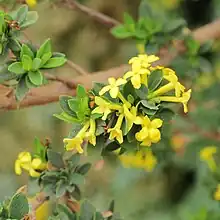| Daphne aurantiaca | |
|---|---|
 | |
| Scientific classification | |
| Kingdom: | Plantae |
| Clade: | Tracheophytes |
| Clade: | Angiosperms |
| Clade: | Eudicots |
| Clade: | Rosids |
| Order: | Malvales |
| Family: | Thymelaeaceae |
| Genus: | Daphne |
| Species: | D. aurantiaca |
| Binomial name | |
| Daphne aurantiaca Diels.[1] | |
Daphne aurantiaca (syn. Daphne calcicola) is a shrub of the family Thymelaeaceae. It is native to China, specifically Sichuan and Yunnan.[1]
Description
The shrub is evergreen, and grows from 0.6 to 1.2 meters tall. Its different variants grow either erect or more prostrate, accounting for the variance in height.[2] It is often found on slopes and ledges, particularly the faces of limestone cliffs.[1] It was introduced to European gardens by George Forrest in 1906, from collections in the Lijiang Range in NW Yunnan. He described it as "One of the most beautiful plants in western Yunnan".[3]
Varieties
There are two varieties:
References
- 1 2 3 "Daphne aurantiaca Diels". eFloras.org. Retrieved 3 April 2016.
- 1 2 "Daphne aurantiaca var. aurantiaca Diels (1912) / var. calcicola (Smith) J.J. Halda (2001)". Seidelbast. Retrieved 3 April 2016.
- 1 2 "Daphne calcicola". Alpine Garden Society. Retrieved 26 November 2017.
This article is issued from Wikipedia. The text is licensed under Creative Commons - Attribution - Sharealike. Additional terms may apply for the media files.